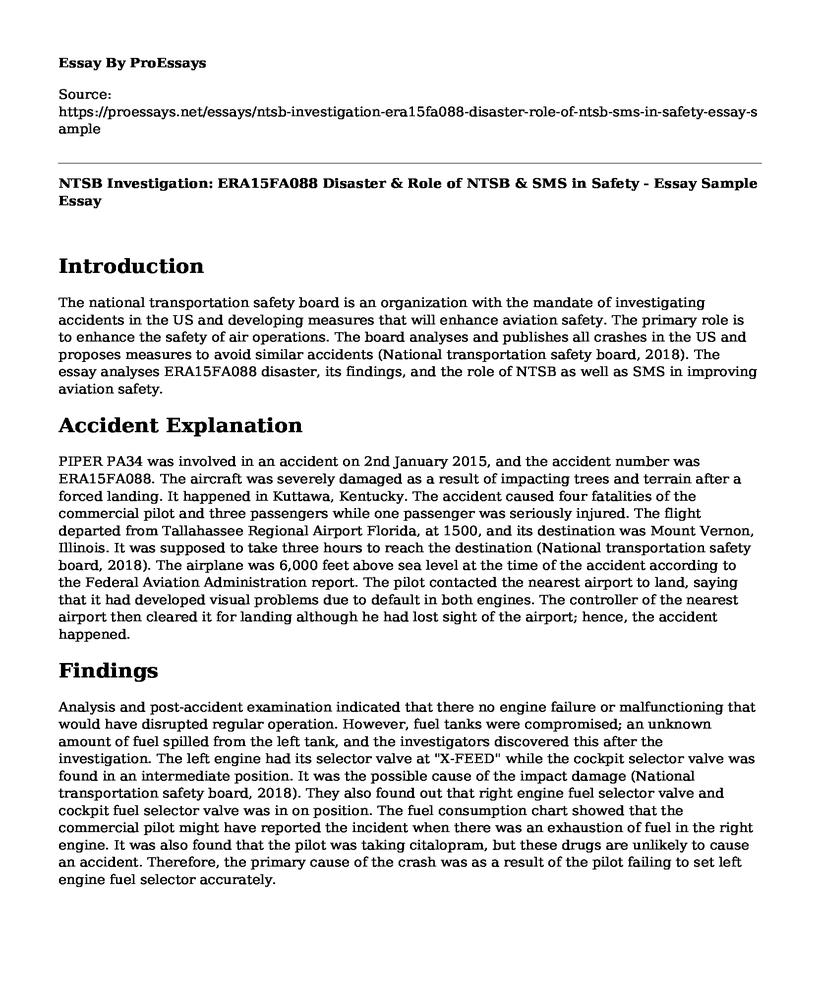Introduction
The national transportation safety board is an organization with the mandate of investigating accidents in the US and developing measures that will enhance aviation safety. The primary role is to enhance the safety of air operations. The board analyses and publishes all crashes in the US and proposes measures to avoid similar accidents (National transportation safety board, 2018). The essay analyses ERA15FA088 disaster, its findings, and the role of NTSB as well as SMS in improving aviation safety.
Accident Explanation
PIPER PA34 was involved in an accident on 2nd January 2015, and the accident number was ERA15FA088. The aircraft was severely damaged as a result of impacting trees and terrain after a forced landing. It happened in Kuttawa, Kentucky. The accident caused four fatalities of the commercial pilot and three passengers while one passenger was seriously injured. The flight departed from Tallahassee Regional Airport Florida, at 1500, and its destination was Mount Vernon, Illinois. It was supposed to take three hours to reach the destination (National transportation safety board, 2018). The airplane was 6,000 feet above sea level at the time of the accident according to the Federal Aviation Administration report. The pilot contacted the nearest airport to land, saying that it had developed visual problems due to default in both engines. The controller of the nearest airport then cleared it for landing although he had lost sight of the airport; hence, the accident happened.
Findings
Analysis and post-accident examination indicated that there no engine failure or malfunctioning that would have disrupted regular operation. However, fuel tanks were compromised; an unknown amount of fuel spilled from the left tank, and the investigators discovered this after the investigation. The left engine had its selector valve at "X-FEED" while the cockpit selector valve was found in an intermediate position. It was the possible cause of the impact damage (National transportation safety board, 2018). They also found out that right engine fuel selector valve and cockpit fuel selector valve was in on position. The fuel consumption chart showed that the commercial pilot might have reported the incident when there was an exhaustion of fuel in the right engine. It was also found that the pilot was taking citalopram, but these drugs are unlikely to cause an accident. Therefore, the primary cause of the crash was as a result of the pilot failing to set left engine fuel selector accurately.
Role of NTSB and SMS Principles in Preventing Similar Accidents
The National Transportation Safety Board has a responsibility of investigating aviation accidents in the US developing safety principles to prevent similar accidents from happening. The primary role of the board is to improve aviation safety by developing safety policies and laws to follow. It investigates accidents and their causes as well as recommending safety measures airplanes should follow; thus preventing similar accidents (Dillingam, 2010). As an independent agency, it has the authority to investigate any accidents and call it the way it is as well as improving future safety measures by identifying underlying weaknesses regarding safety measures.
Besides, the safety management system principles contribute t improving aviation safety. They include policy, risk management, assurance, and promotion. The aviation safety policy should be integrative by engaging all stakeholders, and ensure employees appreciate and uphold it so that they avoid risk behaviors. Risk management is another principle explaining how easy it is to report accidents and the ability to gather feedback from the stakeholders (Stolzer & Goglia, 2016). Assurance is the third principle that helps aviation operators to ensure effective and efficient implementation of safety measures as well as reviewing the policies adequately. Lastly, promotion principle helps to communicate aviation safety policies to ensure all stakeholders do what is right regarding safety. Therefore, these principles contribute to enhancing aviation safety.
Conclusion
The primary role of the National Transportation Safety Board is improving transportation safety. It investigates aviation accidents and their causes aiming, to develop better safety policies to avoid similar accidents. It supports the growth of training centers, so that aviation operators engage in activities upholding airspace safety as well as advocating for the implementation of the safety management system.
References
Dillingam, G. (2010). National Transportation Safety Board: Issues related to the 2010 re-authorization. New York: NTSB.
National transportation safety board. (2018). Aviation accident database & synopsis. Retrieved from https://www.ntsb.gov/_layouts/ntsb.aviation/index.aspx
Stolzer, A & Goglia, J. (2016). Safety management systems in aviation. New York: Routledge.
Cite this page
NTSB Investigation: ERA15FA088 Disaster & Role of NTSB & SMS in Safety - Essay Sample. (2023, Jan 17). Retrieved from https://proessays.net/essays/ntsb-investigation-era15fa088-disaster-role-of-ntsb-sms-in-safety-essay-sample
If you are the original author of this essay and no longer wish to have it published on the ProEssays website, please click below to request its removal:
- Characteristics of Effective Teams
- Paper Example on Qatar Airways Strategy
- The Great Man Theory Essay
- Paper Example on Transformational Leadership
- Transformational Leadership & Job Design Impact on Employee Wellness & Performance - Essay Sample
- Essay on Educational Leaders' Roles Changed by Technology: Challenges and Opportunities
- Report Sample on Defining Quality Software: Attributes, Priorities, and Satisfaction







